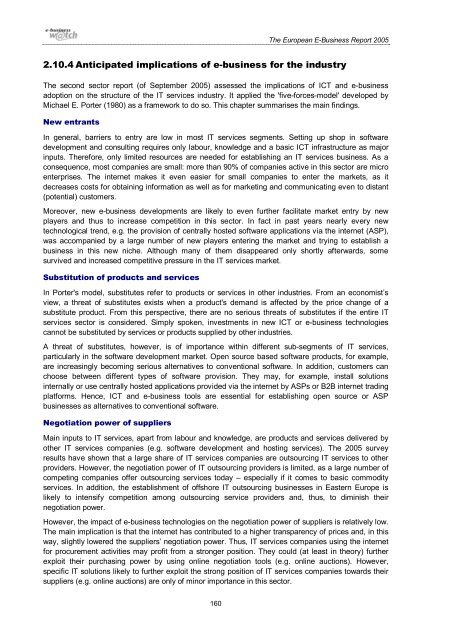The European e-Business Report The European e ... - empirica
The European e-Business Report The European e ... - empirica
The European e-Business Report The European e ... - empirica
Create successful ePaper yourself
Turn your PDF publications into a flip-book with our unique Google optimized e-Paper software.
<strong>The</strong> <strong>European</strong> E-<strong>Business</strong> <strong>Report</strong> 2005<br />
2.10.4 Anticipated implications of e-business for the industry<br />
<strong>The</strong> second sector report (of September 2005) assessed the implications of ICT and e-business<br />
adoption on the structure of the IT services industry. It applied the 'five-forces-model' developed by<br />
Michael E. Porter (1980) as a framework to do so. This chapter summarises the main findings.<br />
New entrants<br />
In general, barriers to entry are low in most IT services segments. Setting up shop in software<br />
development and consulting requires only labour, knowledge and a basic ICT infrastructure as major<br />
inputs. <strong>The</strong>refore, only limited resources are needed for establishing an IT services business. As a<br />
consequence, most companies are small: more than 90% of companies active in this sector are micro<br />
enterprises. <strong>The</strong> internet makes it even easier for small companies to enter the markets, as it<br />
decreases costs for obtaining information as well as for marketing and communicating even to distant<br />
(potential) customers.<br />
Moreover, new e-business developments are likely to even further facilitate market entry by new<br />
players and thus to increase competition in this sector. In fact in past years nearly every new<br />
technological trend, e.g. the provision of centrally hosted software applications via the internet (ASP),<br />
was accompanied by a large number of new players entering the market and trying to establish a<br />
business in this new niche. Although many of them disappeared only shortly afterwards, some<br />
survived and increased competitive pressure in the IT services market.<br />
Substitution of products and services<br />
In Porter's model, substitutes refer to products or services in other industries. From an economist’s<br />
view, a threat of substitutes exists when a product's demand is affected by the price change of a<br />
substitute product. From this perspective, there are no serious threats of substitutes if the entire IT<br />
services sector is considered. Simply spoken, investments in new ICT or e-business technologies<br />
cannot be substituted by services or products supplied by other industries.<br />
A threat of substitutes, however, is of importance within different sub-segments of IT services,<br />
particularly in the software development market. Open source based software products, for example,<br />
are increasingly becoming serious alternatives to conventional software. In addition, customers can<br />
choose between different types of software provision. <strong>The</strong>y may, for example, install solutions<br />
internally or use centrally hosted applications provided via the internet by ASPs or B2B internet trading<br />
platforms. Hence, ICT and e-business tools are essential for establishing open source or ASP<br />
businesses as alternatives to conventional software.<br />
Negotiation power of suppliers<br />
Main inputs to IT services, apart from labour and knowledge, are products and services delivered by<br />
other IT services companies (e.g. software development and hosting services). <strong>The</strong> 2005 survey<br />
results have shown that a large share of IT services companies are outsourcing IT services to other<br />
providers. However, the negotiation power of IT outsourcing providers is limited, as a large number of<br />
competing companies offer outsourcing services today – especially if it comes to basic commodity<br />
services. In addition, the establishment of offshore IT outsourcing businesses in Eastern Europe is<br />
likely to intensify competition among outsourcing service providers and, thus, to diminish their<br />
negotiation power.<br />
However, the impact of e-business technologies on the negotiation power of suppliers is relatively low.<br />
<strong>The</strong> main implication is that the internet has contributed to a higher transparency of prices and, in this<br />
way, slightly lowered the suppliers’ negotiation power. Thus, IT services companies using the internet<br />
for procurement activities may profit from a stronger position. <strong>The</strong>y could (at least in theory) further<br />
exploit their purchasing power by using online negotiation tools (e.g. online auctions). However,<br />
specific IT solutions likely to further exploit the strong position of IT services companies towards their<br />
suppliers (e.g. online auctions) are only of minor importance in this sector.<br />
160

















